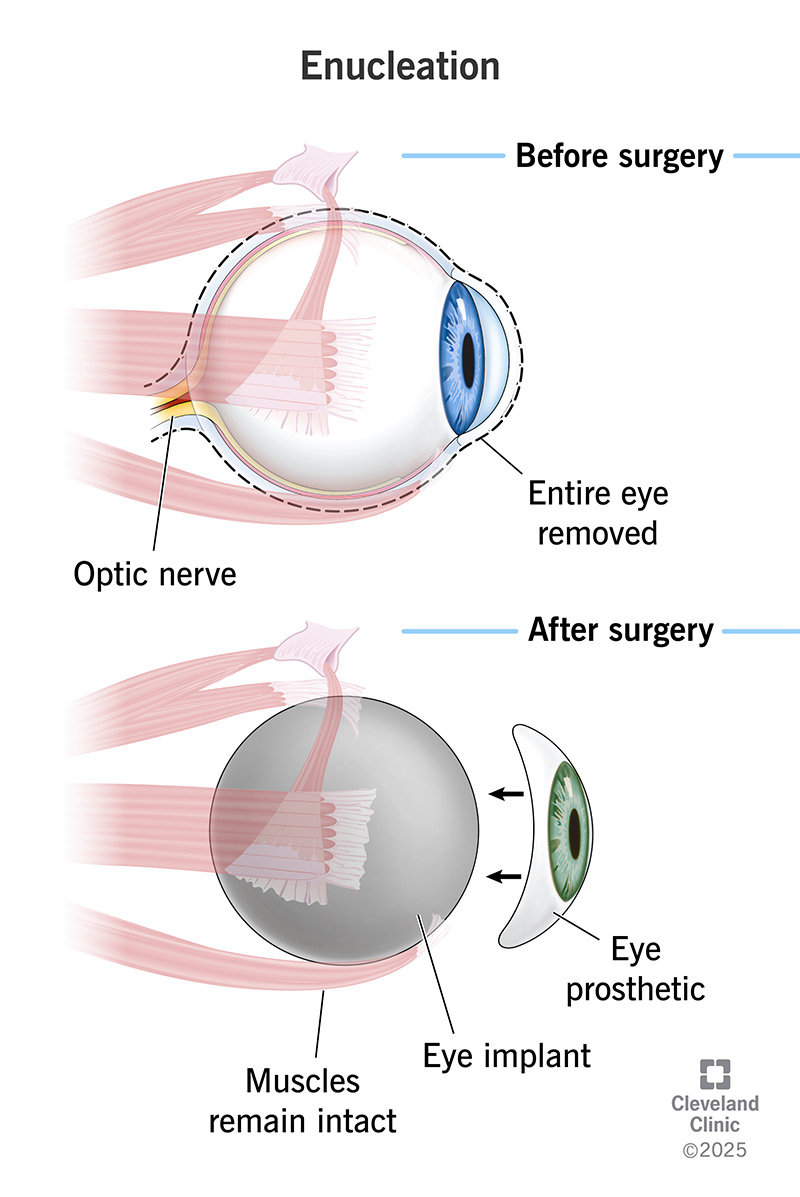Enucleation is surgery to remove one of your eyes. You might need it if a severe injury or health condition permanently damages your eye. A surgeon will remove your natural eye and replace it with a temporary implant. After a few weeks, you’ll meet with a healthcare provider who will design you a permanent prosthetic eye.
Advertisement
Cleveland Clinic is a non-profit academic medical center. Advertising on our site helps support our mission. We do not endorse non-Cleveland Clinic products or services. Policy

Enucleation of the eye is surgery to remove your eye, its contents and part of your optic nerve. A surgeon will remove your entire eyeball. They’ll leave the bones in your eye socket. You can get a prosthetic eye implanted after you recover.
Advertisement
Cleveland Clinic is a non-profit academic medical center. Advertising on our site helps support our mission. We do not endorse non-Cleveland Clinic products or services. Policy
Your eye doctor may recommend enucleation to treat:
Your surgeon will discuss the procedure with you. This can be a big decision. They’ll suggest the best surgery based on your unique situation. Don’t be afraid to ask lots of questions. Share any concerns you have ahead of time.
Tell your surgeon about any prescription or over-the-counter medications you take. Make sure to mention any supplements you use. You may have to stop taking some medications before surgery. Especially if you take blood thinners.
You’ll have to stop eating and drinking for several hours before surgery. Your care team will tell you how long you’ll need to fast.
Arrange transportation to and from surgery. You won’t be able to drive yourself home.
An anesthesiologist will give you anesthesia to make sure you don’t feel pain during the surgery. You’ll probably get general anesthesia. This will put you to sleep. You might need local anesthesia that numbs the area around your eye. In this case, you’ll also need a sedative to help you relax.
Advertisement
Enucleation usually takes around an hour. It usually follows these steps:
Enucleation can be the best way to protect your health and remaining vision. It’s a safe, effective way to remove damaged tissue or treat diseases that might spread to other parts of your body. It can also relieve pain, especially if other treatments haven’t helped.
It can also help you change your appearance. If you don’t like the way your natural eye looks, enucleation can be the first step to getting an ocular prosthetic. You can pick an implant that matches your preferences. This can help you feel more like yourself.
Like all surgeries, there are some risks, including:
Your care team will move you to a recovery area after eye removal surgery. They’ll make sure you wake up from anesthesia safely. They’ll also monitor your pain level.
You should be able to go home the same day. But your care team will let you know if you’ll need to stay in the hospital overnight.
Your provider will prescribe pain medications. They may give you antibiotics if your eye was infected. You’ll be able to take over-the-counter pain relievers like acetaminophen. Your surgeon may tell you to avoid NSAIDs because they can increase your risk of bleeding. Your care team will tell you which medications are best. They’ll let you know how often you can take pain relievers. And they’ll show you how to care for your surgery site.
It usually takes a month or two to recover from eye enucleation. You’ll need to avoid intense physical activities for a few weeks after the procedure. Don’t bend over or lift anything heavy for about a month. Your care team will tell you when it’s safe to resume your usual physical activities.
Advertisement
You’ll probably need to visit your surgeon a week after enucleation. They’ll remove the pressure bandage. They’ll check on your healing and look for signs of complications at this visit.
After about six to eight weeks, you should be healed enough to meet with an ocularist. This is a technical artist who makes, fits and paints prosthetic eyes. They’ll design your artificial replacement eye.
Call your surgeon right away if you experience any of the following:
Choosing to have enucleation can feel like a big decision. And it is. But if it’s the right option for you, it can make a huge difference in your quality of life. No matter why you need eye removal surgery, your care team will help you understand all the steps and the recovery process. Your healthcare providers will help you feel confident that you’re doing what’s best for you and your health.
Once you recover from the surgery, your ocularist will help you design a prosthetic eye. You’ll be able to pick one that keeps your eye socket safe and matches your cosmetic preferences.
Advertisement
Cleveland Clinic’s ophthalmologists and optometrists have the highest training available. We provide exams, vision correction and care for many eye conditions.

Last reviewed on 01/02/2026.
Learn more about the Health Library and our editorial process.